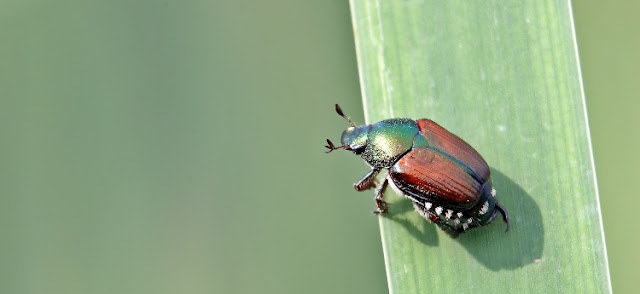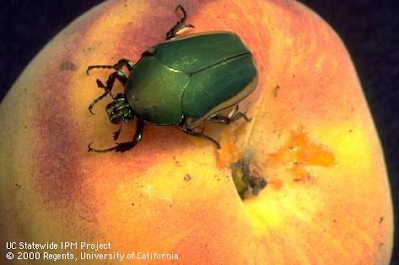
|
|
Japanese beetles are serious destructive pests. Hundreds of traps are now out in a 49-square-mile area. (Photo courtesy Sacramento County Agricultural Commission)
|
Trapping follows discoveries in Rancho Cordova, Arden-Arcade
America’s No. 1 turf pest is trying to invade Sacramento – again. But much more than lawn is at stake. This bad bug is a major threat to California agriculture, too; it can destroy more than 300 crops including wine grapes, citrus and stone fruit. And it really likes roses, too.
The dreaded Japanese beetle has been discovered in two locations in Sacramento County, triggering a massive trapping campaign.
According to the Sacramento County Agricultural Commissioner and the California Department of Food and Agriculture, a total of 19 Japanese beetles – eight in Arden-Arcade and 11 in Rancho Cordova – were recently found. Those initial detections were confirmed June 4, the county announced Tuesday.
This week, state and county staff placed hundreds of green plastic traps over a 49-square-mile area. Those beetle traps will be monitored daily within a mile of the initial sightings; weekly farther away.
Most of the traps are placed near Japanese beetles’ favorite domain – lush green lawn. Its grubs devour the roots of turf grasses, causing an estimated $250 million in damage annually, according to the USDA.
As their name implies, Japanese beetles are native to Japan, where they are not considered a pest. Natural predators keep their numbers in check. But in North America, Japanese beetles have found an unlimited buffet with no predators to stop them. And they eat their entire lives; below ground as larvae on roots, and above ground as adults on fruit and foliage, which they skeletonize.
“Among the plants most commonly damaged are apple, pears, cherries, corn, grapes, roses and turfgrass,” said the county’s announcement. “Adults leave behind skeletonized leaves and large, irregular holes. The grubs develop in soil, feeding on the roots of various plants and grasses and often destroying turf in lawns, parks, golf courses and pastures.”
Sacramento County residents are urged to be on the lookout for this pest. The Arden-Arcade discovery was made near the intersection of Watt and Whitney avenues.
According to the CDFA website, these are the first Japanese beetles to be detected in Sacramento County neighborhoods since 2017 when one beetle was trapped in Fair Oaks.
The adults appear in June and July before tunneling back underground to lay eggs. Those eggs hatch in late summer and the larvae spend the next nine months eating roots.

|
|
This is a fig beetle or green fruit beetle, which is sometimes
mistaken for a Japanese beetle. But it's nearly twice as large as the
invasive pest -- up to 1-1/3 inches long. (Photo courtesy UC IPM)
|
About a half-inch long with bronze iridescent wings, Japanese beetles look a lot like other beetles common in Sacramento in early summer, including fig, hoplia and June beetles. But the Japanese beetle is a lot more destructive. Among the trees at highest risk: Japanese maple, crape myrtle, apple, stone fruit (peach, plum, apricot, pluot, cherry etc.), pin oak, linden, birch, black walnut, Lombardy poplar and willow.
Herbaceous plants most likely to be attacked include: Roses, grapes, sweet corn, asparagus, dahlias, sunflowers, hollyhocks, peonies, gladiola and zinnias. The grubs, which are white and about an inch long, love lawns of all sorts.
If you think you’ve seen Japanese beetles in your garden, call the Sacramento County Agricultural Commissioner’s office at (916) 875-6603 or the state’s Pest Hotline at (800) 491-1899.
Details:
https://www.cdfa.ca.gov/plant/jb/


